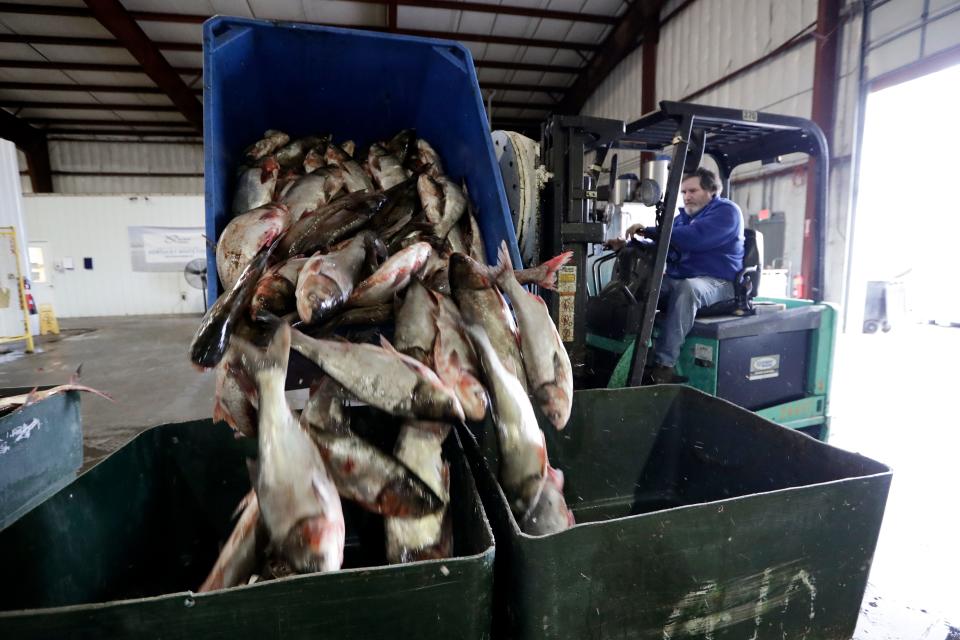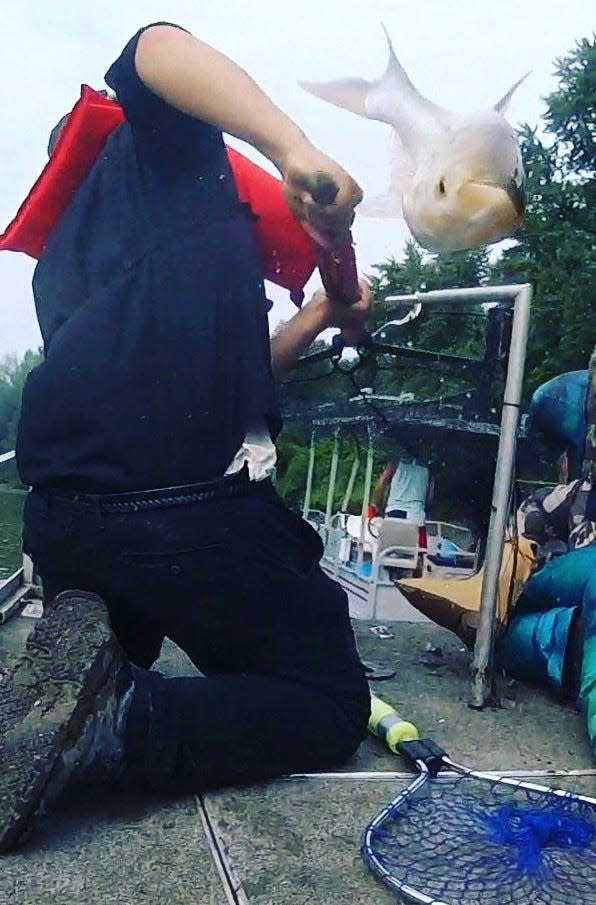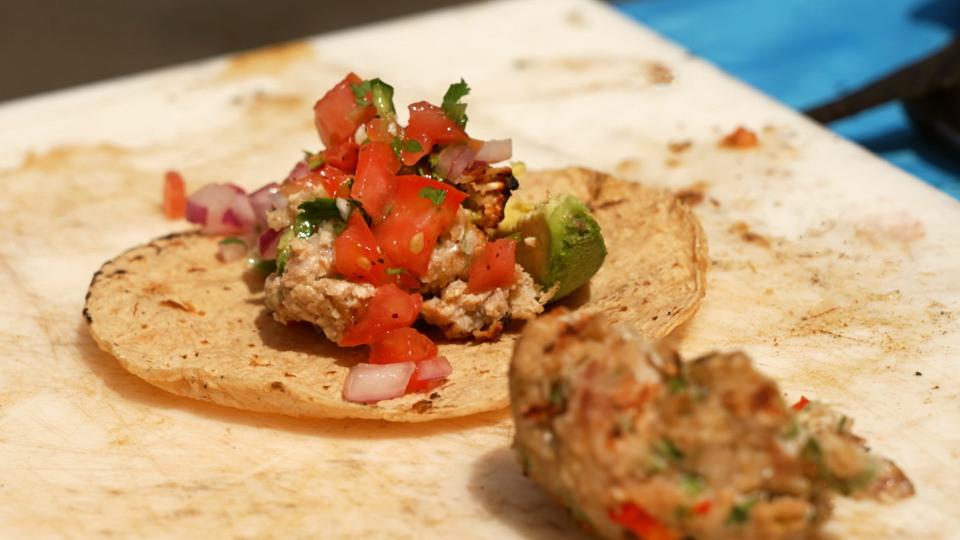Inside the Illinois Department of Natural Resources' efforts to rebrand Asian carp
The news clip running on an Illinois television station had an apocalyptic, end-of-the-world feel to it.
It showed a fleet of sturdy jon boats racing up a river, carrying combatants armored in battered football helmets and catcher’s masks and armed with tennis rackets and bats.
As the television camera looked on, finny torpedoes would suddenly detach themselves from the murky river waters and leap into the air to deliver a dope slap to any of the boat crews who’s attention had wandered.
This startling — but entertaining — visual was for many viewers their first introduction to a foreign invader that is dramatically changing the piscatorial population of many Midwestern rivers.
The newcomer was the Asian carp, that first came to this country in the 1960s as a guest of Arkansas aqua farms facing problems with plankton and algae.
The Asian carp got an invitation because it loves to munch on the aquatic plant life that is the bane of commercial fish farm operations.

How Asian carp invaded U.S. river systems
The carp initially was thought to be a low-cost, natural means of controlling the weed problem. But like many instances of man placing his thumb on nature’s balance, it has proven to be an ecological disaster since the fish escaped into the river systems. They have been in the Mississippi River since the 1980s.
The Asian carp, now plaguing the nation’s waterways, comes in four varieties and is not to be confused with the common bottom feeder and exotic import, the European carp.
There are the silver, bighead, black and grass carp and all have a voracious appetite — plus a strange aversion for the turbulence of passing boat motors.
More: Veteran boaters share Mississippi River safety tips: 'If you don't respect it, it will eat you up'

Invasive species poses dangers to river-goers and biodiversity
The churning waters drive the carp to leap as much as 10 feet up from the water in a frenzied dance that can lead to collisions with boaters, water skiers and work crews. On some rivers — such as the Illinois — the fish are so thick that boaters have made it a sport to venture onto the river and do battle with the flying fish.
But it is not the Asian carp’s proclivity to become airborne that makes it a threat to the health of the Midwestern river system. Rather, it is its appetite for plankton and algae — a diet that had earned it the name of “filter feeder.”
The Asian carp’s diet causes a crash in zooplankton and phytoplankton that are important sources of food for other juvenile fish. Asian carp scoop up the food necessary for other fish species to survive.
The population explosion of the filter feeders is especially dire in the Illinois River, where it is estimated that 70% of the biomass in the river is the Asian visitor.
The U.S. Army Corps of Engineers and the Illinois Department of Natural Resources are presently battling to keep the carp from ascending the river and gaining entry into the Great Lakes, where they could destroy a $7 billion commercial fisheries.
More: Monarchs are now endangered. Here's how you can help the species in Southeast Iowa.
Locks and dams may be discouraging carp Upper Mississippi waterways
The situation on the nearby Upper Mississippi River does not mirror the Illinois, and earlier forecasts of a mass infestation of Asians has so far proved incorrect. While the carp threatens entry into the Great Lakes system via the Illinois River, the infestation on the Mississippi River appears to have paused at Iowa’s southern border.
Roy Bowman, an Iowa Department of Natural Resources fisheries technician, explained that the Mississippi’s series of locks and dams appear to be discouraging the arrival of Asian carp.
“Lock and dam 19 at Keokuk is especially high and seems to be a barrier for the Asian carps' movement upstream," Bowman said. "But how long this will hold is hard to determine. The Des Moines River enters the Mississippi downstream of the Keokuk dam, and the Des Moines has significant numbers of the fish.”
Jon Billups, manager of Burlington’s Bluff Harbor Marina, also explained he has heard few reports of Asian Carp in this pool.
But he concedes the species is numerous in the Des Moines River.
He added that he has seen videos taken by a marina employee of the fish leaping out of the Des Moines River as a jet ski passes by.
The lack of any extensive infestation of Asian carp on the Upper Mississippi is also confirmed by Kirby Marsden at Quality Fisheries in Fort Madison.
More: 'A hidden gem': A look at New Crystal Lake Club's long and storied history of conservation
Illinois launches rebranding campaign in an effort to make carp more desirable
Quality Fisheries is the area’s largest processor of fish taken by commercial fishermen in Pool 19.
“There is just not a commercial market for Asian carp,” explained Marsden. “To begin with, they have a bone structure that is really difficult to deal with. When you finally get the bones out there just is not that much of the fish left. It is just too much work to process.”
Marsden goes on to add that there is also a reluctance by the public to consume the fish that is basted with the same bad reputation brush as the bottom-feeding European carp.
“Very few people want to eat any fish that is called a ‘carp.' Carp can be popular in other countries, but not here,” Marsden said. “This is really unfortunate because I think Asian carp taste great — as least as good as wild-caught salmon. It is just that it is too expensive to process and there is no market for it.”
The reluctance of the public to fry up a “mess” of Asian carp has not discouraged the Illinois Department of Natural Resources as it has spent the past two years developing a marketing campaign to make the fish more acceptable.
In June, the Illinois agency unveiled the first step in this approach when it announced the Asian carp had undergone an identity change.
The fish will now be known as the “Copi."
The name Copi is derived from how copious the fish are in number and is hoped to make the fish more acceptable. The initial response to the name change has been positive.
Distributors, primarily in the Chicago area, are offering Copi deep-fried, smoked, in burgers, sushi, Thai curries and more.
More: Unlike other Iowa cities, Burlington has steered clear of a water shortage. Here's how.

For Burlington restaurant owners, a carp by any other name is still a carp
The opportunity to order up a Copi burger in a Burlington restaurant appears to be only in the distant future as local food purveyors are presently reluctant to offer the exotic fish to their customers.
Carlo Falcone at the popular Italian eatery, LaTavola, has definite opinions about the reconfigured carp.
“It is just a horrible fish,” he said. “It apparently tastes pretty good, but it is boney and just about impossible to serve.
“It is certainly not the type of fish we want to offer a customer.”
That opinion is echoed at riverside restaurant The Drake, where manager Bryan Atwater explained the Copi would not be welcomed on their menu.
“Whatever you call it, it is still a carp and that is not the kind of fish we want to offer to our customer," Atwater said. "There are places around that offer smoked carp, but that is not what we do.”
Because of the bone structure, the fish is often served ground.
The name change approach is not new when it comes to making a fish more marketable.
The Patagonian tooth fish is successfully sold as Chilean sea bass, while the Slimehead is now known as orange roughy.
Public acceptance of the Copi and the resultant commercial market could significantly reduce the Asian fish population and hopefully keep the voracious algae feeder locked below the Keokuk dam.
This article originally appeared on The Hawk Eye: Why the Illinois Department of Natural Resources renamed carp

